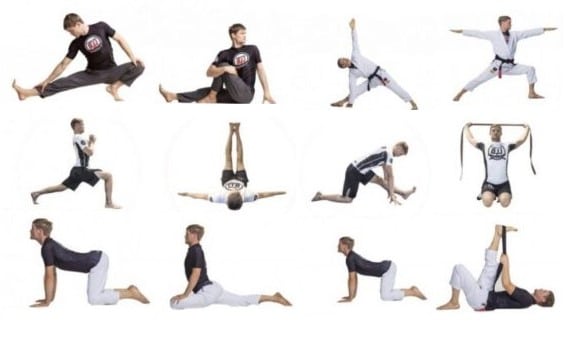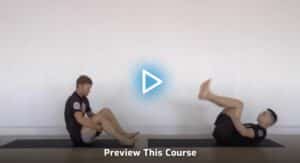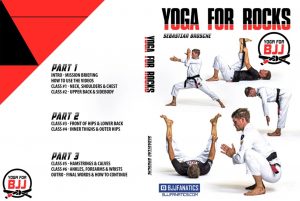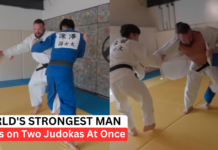
Jiu-jitsu is a martial art known for focusing on ground fighting and submissions. What jiu-jitsu requires in many situations are strength, strategy, and agility.
While these are crucial elements for jiu-jitsu success, one overlooked component greatly contributes to the enjoyment of training, effortless practice, and overall impression of the sport.
When we mention flexibility, it’s not just about the easier execution of flashy moves. Flexibility transforms your jiu-jitsu experience into something much better. It elevates your enjoyment of the sport to a higher level. Here’s how.
Enhanced Mobility and Range of Motion
Flexibility undoubtedly gives you a broader range of motion, allowing you to perform many techniques that would otherwise be difficult or impossible.
As someone who has been focusing exclusively on open guard and guard retention for over ten years, I know how important it is to have flexible hips. Hips are, alongside proper techniques, the most important aspect of guard retention.
Additionally, flexible hips make it easier to transition between various guards, adapt to new situations, and respond to your opponent’s reactions. It is also much easier to maintain control and set up submissions.
Improved Defensive Capabilities
A crucial fact is that a flexible body can easily escape tight spots. When someone applies pressure, and you are flexible, you will notice how even a shrimp escape becomes more efficient. This also applies to full mount and side control, where a flexible person can maneuver more easily.
What’s essential is that someone flexible not only escapes submissions and bad positions more easily but also expends much less energy in the process, as the struggle with their own body is reduced.
Effortless Transitions and Flow
You may have heard that jiu-jitsu is often described as a “game of human chess,” where fluidity and the ability to transition smoothly between positions are paramount. Flexibility significantly aids in transitions and the overall game of human chess. For flexible people, the concept of the game of human chess becomes clear by the second training session, while those who are not flexible might struggle even after a long time, as every transition represents a battle with their own and their opponent’s body.
It’s important to note that flexibility enhances your movements, making them more effective, aesthetically pleasing, and enjoyable.

Reduced Risk of Injury
In a physically demanding sport like jiu-jitsu, the risk of injury is always present. However, flexibility significantly reduces the risk of injury and serves as a protective measure. Flexible joints, tendons, and muscles are much better at absorbing impacts and protecting against sudden stretches and awkward movements.
For flexible practitioners, the possibility of strains, sprains, and other common injuries is so reduced that it is rare to find practitioners over 50 who aren’t flexible. Injuries tend to sideline those who are not flexible, diminishing their enthusiasm for training in older age unless they drastically commit to yoga or stretching.
Greater Enjoyment and Longevity in the Sport
When you combine better defense, improved mobility, effortless transitioning, and a significantly reduced risk of injury, it all culminates in a much more enjoyable jiu-jitsu experience.
When you are not constantly struggling with your own body due to a limited range of motion, you can focus on various techniques and strategies within the art, which ultimately makes this sport incredibly interesting. All of this leads to a deeper love for the sport and genuine enjoyment of it.
Effortless Jiu-Jitsu Through Flexibility
You’ve probably noticed people in your academy who spar effortlessly. If you take a closer look, most of those who spar effortlessly and have an effortless jiu-jitsu game are flexible. I would say 99.9% of such practitioners are highly flexible and simply enjoy the sport. They are known for being able to do the most sparring rounds and having the best conditioning. However, flexibility is often the main reason for this.
You can notice how easily they defend their guard, and even when they get into difficult situations, they can quickly escape and continue sparring without problems when others cannot.
Additionally, they are often the last ones on the mat, looking for another round of sparring.
It is crucial to note that flexible practitioners usually experience less soreness and muscle tightness after training, which makes recovery easier and allows them to enjoy the training and recovery process more. Consequently, they can train for more hours.
Conclusion
Whether you are a beginner or someone who has been training for a long time, incorporating flexibility training into your routine is something everyone should do. Reduced risk of injury, fluid movements, and effortless training and sparring are things that everyone practicing jiu-jitsu should have in their arsenal. So, get a yoga mat, start stretching, and watch your game flourish.
If you want to know how to start and you don’t have any experience with yoga or stretching, “Yoga For Rocks” by Sebastian Brosche is a great way to start to stretch and enjoy Jiu-Jitsu much more


![Darce Choke Encyclopedia – Origins, Mechanics and Variations [2025] BJJ, choke, Brabo, BJJ Darce Choke, D'arce Choke, Darce BJJ Choke](https://bjj-world.com/wp-content/uploads/2017/11/JungPoirierLeeYahoo-218x150.jpg)













![Slicin’ Calves Mikey Musumeci DVD Review [2025] Slicin' Calves Mikey Musumeci DVD Review](https://bjj-world.com/wp-content/uploads/2025/04/slicin-calves-mikey-musumeci-dvd-review-218x150.png)
![Jiu-Jitsu For Old Guys Guard Retention Bernardo Faria DVD Review [2025] Jiu-Jitsu For Old Guys Guard Retention Bernardo Faria DVD Review](https://bjj-world.com/wp-content/uploads/2025/03/old-guys-guard-retention-bernardo-faria-dvd-review-218x150.png)
![X-Guard Trickery Kyle Sleeman DVD Review [2025] X-Guard Trickery Kyle Sleeman DVD Review](https://bjj-world.com/wp-content/uploads/2025/03/x-guard-trickery-kyle-sleeman-dvd-review-218x150.png)
![Countering with Crab Ride Anthony Budion DVD Review [2025] Countering with Crab Ride Anthony Budion DVD Review](https://bjj-world.com/wp-content/uploads/2025/03/countering-with-crab-ride-anthony-budion-dvd-review-218x150.png)
![Get Off My Legs Gringo Craig Jones DVD Review [2025] Get Off My Legs Gringo Craig Jones DVD Review](https://bjj-world.com/wp-content/uploads/2025/03/get-off-my-legs-gringo-craig-jones-dvd-review-324x235.png)
![Back Hacks Yigit Haney BJJ DVD Review [2025] Back Hacks Yigit Haney BJJ DVD Review](https://bjj-world.com/wp-content/uploads/2024/12/back-hacks-yigit-haney-bjj-dvd-review-100x70.png)



![Jeff Glover Deep Half Revolution DVD Bundle Review [2024] Jeff Glover Deep Half Revolution DVD Bundle Review](https://bjj-world.com/wp-content/uploads/2024/10/jeff-glover-deep-half-revolution-dvd-bundle-review-100x70.png)





![Reverse Arm Bar System Andrew Kerfoot DVD Review [2024] Reverse Arm Bar System Andrew Kerfoot DVD Review](https://bjj-world.com/wp-content/uploads/2024/10/reverse-arm-bar-system-andrew-kerfoot-dvd-review-100x70.png)
![Collar Sleeve Guard Mikey Musumeci DVD Review [2024] Collar Sleeve Guard Mikey Musumeci DVD Review](https://bjj-world.com/wp-content/uploads/2024/12/collar-sleeve-guard-mikey-musumeci-dvd-review-100x70.png)
![Foot Sweep the World Dainis Nguyen-Huu DVD Review [2024] Foot Sweep the World Dainis Nguyen-Huu DVD Review](https://bjj-world.com/wp-content/uploads/2024/11/foot-sweep-the-world-dainis-nguyen-huu-dvd-review-100x70.png)
![Mastering Control From Top Position Trent Hidlay DVD Review [2024] Mastering Control From Top Position Trent Hidlay DVD Review](https://bjj-world.com/wp-content/uploads/2024/11/control-from-top-position-trent-hidlay-dvd-review-100x70.png)
![Countering Triangles And Omoplatas Adam Mazin DVD Review [2024] Countering Triangles And Omoplatas Adam Mazin DVD Review](https://bjj-world.com/wp-content/uploads/2024/10/countering-triangles-and-omoplatas-adam-mazin-dvd-REVIEW-100x70.png)



![Leg Lock Strategies: Navigating Entanglements Jack Stapleton DVD Review [2024] Leg Lock Strategies: Navigating Entanglements Jack Stapleton DVD Review](https://bjj-world.com/wp-content/uploads/2024/12/navigating-entanglements-jack-stapleton-dvd-review-100x70.png)

![Front Headlock and Turtle Escapes Brian Glick DVD Review [2024] Front Headlock and Turtle Escapes Brian Glick DVD Review](https://bjj-world.com/wp-content/uploads/2024/11/headlock-and-turtle-escapes-brian-glick-dvd-review-100x70.png)
![Guard Busters Bill Cooper BJJ DVD Review [2025] Guard Busters Bill Cooper BJJ DVD Review](https://bjj-world.com/wp-content/uploads/2025/03/guard-busters-bill-cooper-bjj-dvd-review-100x70.png)
![Basic Closed Guard Jasmine Rocha DVD Review [2024] Basic Closed Guard Jasmine Rocha DVD Review](https://bjj-world.com/wp-content/uploads/2024/11/basic-closed-guard-jasmine-rocha-dvd-review-100x70.png)
![No-Gi Pressure Mastery JT Torres DVD Review [2024] No-Gi Pressure Mastery JT Torres DVD Review](https://bjj-world.com/wp-content/uploads/2024/10/no-gi-pressure-mastery-jt-torres-dvd-review-100x70.png)
![Roger Gracie Guard Passing System DVD Review [2025] Roger Gracie Guard Passing System DVD Review](https://bjj-world.com/wp-content/uploads/2025/02/roger-gracie-guard-passing-system-dvd-review-100x70.png)
![Darces From Everywhere Kade and Tye Ruotolo DVD Review [2024] Darces From Everywhere Kade and Tye Ruotolo DVD Review](https://bjj-world.com/wp-content/uploads/2024/10/darces-from-everywhere-kade-and-tye-ruotolo-dvd-cover-100x70.png)

![Jett Thompson Master Ankle and Aoki Lock DVD Review [2024] Jett Thompson Master Ankle and Aoki Lock DVD Review](https://bjj-world.com/wp-content/uploads/2024/09/jett-thompson-master-ankle-and-aoki-lock-dvd-review-100x70.png)